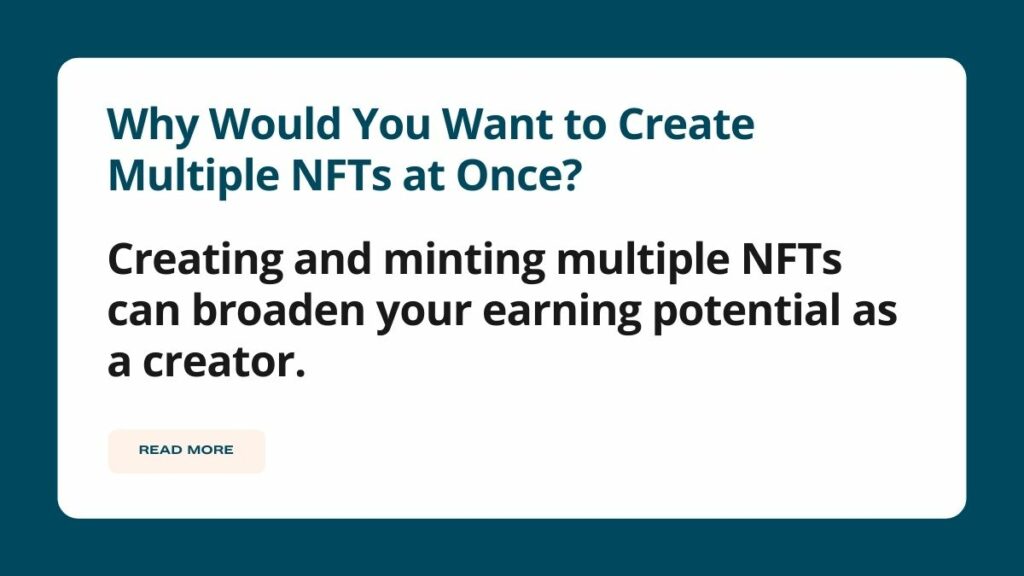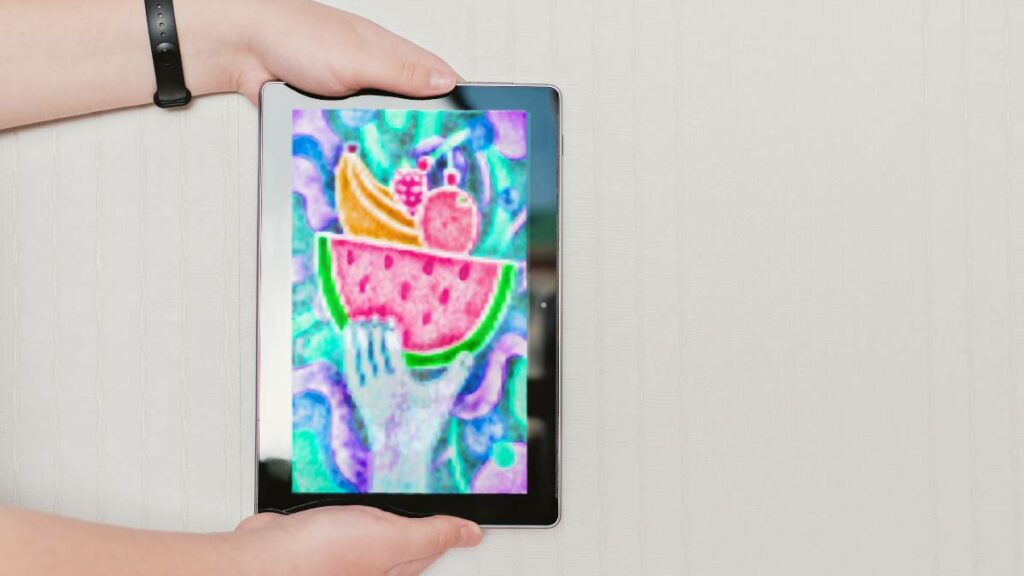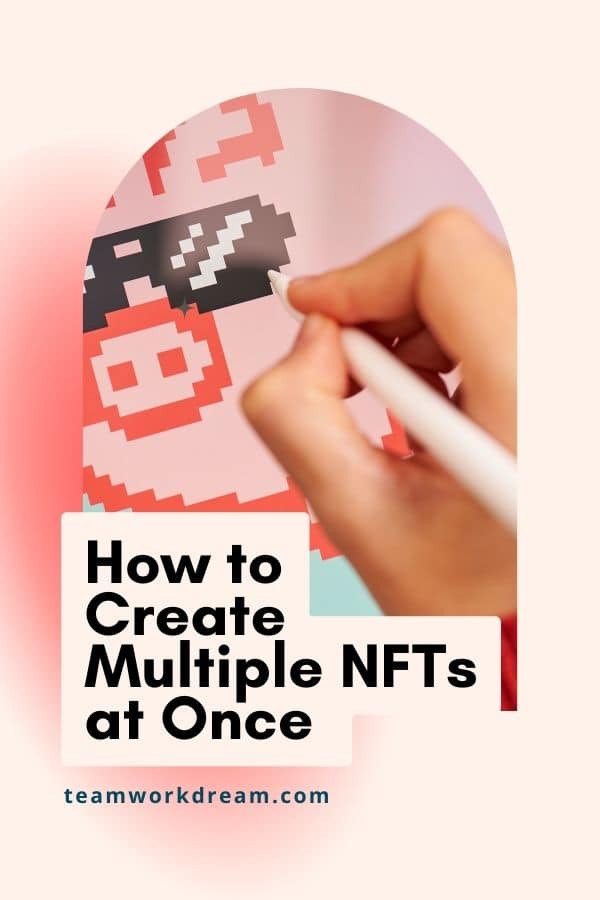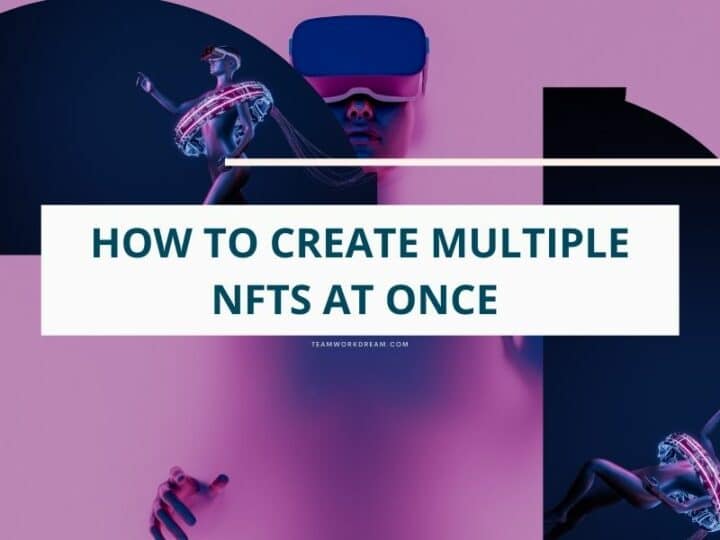Want to take your NFT creation to the next level? Here’s everything you need to know about creating multiple NFTs at once.
These days it doesn’t take earth-shattering discoveries or inventions to make an impact in society. With modern artistic expression joining the digital age in the form of NFTs (or Non-Fungible Tokens), the possibilities are endless.
If you’re new to NFTs, check at our guide to making and selling NFT art before you start.
Creating a unique NFT is equal to painting a one-of-a-kind masterpiece and selling it to the highest bidder at an auction. This practice now has a new home in minting and selling an NFT on the blockchain.
The biggest fish in the NFT pond is all about impression, quality, and quantity. In short, how big of a splash you make in the NFT world depends on your ability to create better and bigger numbers of NFTs.
But, before we take a deep dive into how to generate multiple NFTs at once, let’s unpack a few terms you will need to know to get you started on your digital asset creating journey.
Terms to Remember:
- NFT – An NFT is a Non-Fungible Token. This is a non-replaceable digital asset, each unique and ownership stamped.
- Blockchain – The blockchain is a publicly accessible decentralized ledger that records every transaction within a peer-to-peer (this peer-to-peer network is the collection of connected users who maintain and update the ledger) network.
- Decentralized Ledger – Having no authoritative body which controls incoming and accessible data reflected in the ledger.
- Peer-to-Peer Network – This refers to a connected system of more than one PC, being able to share files and device control.
- Cryptography – Cryptography refers to collecting and exchanging data between peer-to-peer networks.
- Cryptocurrency – Also known as ‘crypto,’ cryptocurrency refers to a digital or virtual currency, such as Bitcoin or Ethereum, which is used to buy and sell a digital asset.
- Minting – This is when an NFT gets an official placement on the blockchain and becomes tradable.
- Collection – A collection refers to NFTs that share a common theme or idea.
- Visual Studio Code – This is a free-to-use coding platform that creators use to generate multiple NFTs.
Why Would You Want to Create Multiple NFTs at Once?

An NFT can be many things. At its most basic, it is a unique once-off digital asset that carries value based on its rarity.
This includes an image, piece of music, news article, or any other visual expression. Creating an NFT means adding a digital certificate of ownership and a value stamp to a computer-generated creation.
However, creating an NFT without minting it on the blockchain is quite pointless. Minting is an integral part of NFTs because you allow it to be purchased and its ownership to be transferred to its new owner.
Creating multiple NFTs for a collection can broaden the earning potential you (as a creator) might have. And knowing how to make multiple NFTs at once is crucially important.
What is the Best Way to Generate Multiple NFTs?

It can be pretty intimidating when you look at how to make multiple NFTs. It’s important to remember that creating an NFT and generating multiple NFTs are two different things.
When you intend to generate multiple NFTs, you’re taking your original NFT artwork, including its different graphic layers and elements, and reassembling them. Doing this countless times in different ways will make them unique from each other.
This way, you keep your original one intact but recreate it multiple times with notable changes made to each one to generate more purchasable pieces. You can choose to make these changes big or small. However, at its core, each is still based on the original artwork.
Repeating this process a few times will ultimately result in a collection based on your original NFT. Therefore, an NFT package includes different versions of the original.
This is an essential part of being a successful NFT developer. And as a developer, you will need to know everything about NFTs, from single file creation to batch-minting.
Creating your first unique NFT is a process, and if you know nothing about its intricacies, it can be tricky. The task of then generating multiple versions of your NFT for a profitable collection has the potential to break your brain.
Luckily, we’re here to ensure the only thing that gets broken is the belief that generating multiple NFTs must be a complicated experience.
Coding Your Way to Multiple NFTs
To simplify this process, you will need to know a bit about coding. Especially the coding that goes into making an NFT. A single NFT consists of layers of code, with each layer representing a different part of your artwork.
This means that one layer could be the basic shape of your NFT, another layer could be the color, and so on. You can think of these layers as lines of code.
Once you have your first visual piece of art, you’ll also have its version as a source code. Think of your source code as your first NFT in code version, which contains your variety of layering code.
Next is the programmatic generation process. Programmatical generation, in essence, is the best way to generate multiple NFTs at a time. Using programmatical generation means you’ll be taking the source code of your NFT and use an auto code generator to recreate different instances or patterns of your code.
You can use a platform like Visual Studio Code (VSC) to help you in this part of your NFT journey.
The result is a collection of different source codes under the banner of your original code. In NFT terms, you’ll have several different versions of your original NFT artwork.
How to Generate Thousands of NFTs?

Taking your NFT and generating thousands of different versions is how most NFT creators work.
Looking at Cryptopunks and Bored Ape Yacht Club, with their collections consisting of thousands of NFTs, it is easy to generate thousands at a time. Doing this consists of a few steps.
Create a Collection of Layers
The first thing you’ll need, as mentioned earlier, is a collection of layers.
Creating one NFT will produce a small number of different layers resulting in one particular image. Making thousands of NFTs, in contrast, will need far more than a few layers.
These layers (each a separate PNG file) will be aspects of your image that you can either create by yourself using software, such as Photoshop, or outsource this creation process.
Use Visual Studio Code to Build a Generation Engine
Once you have your collection of layers, the next step involves using Visual Studio Code to build your own generation engine. This will then automate your creation process by taking all of your custom layers (PNG files) and creating random combinations.
Before you start this process, you will need to define the size of your collection. This means telling your engine to generate many different images using the layers you provide.
In most instances of a generation engine, this is done during your engine’s initial configuration or setup. The total number is up to you, but be advised that generating thousands of NFTs will require many different layers.
Now that your generating engine has delivered a collection of NFTs, you’ll need to know how to upload these digital assets.
Can You Upload Multiple NFTs?
The second most important part of the NFT game after creation is minting. Uploading your NFT to the blockchain, or minting it on the blockchain (using software such as Remix), is how your NFT gets value, ownership, and exposure.
Minting can be a lengthy process, raising the question, can you mint multiple NTFs at once?. The answer lies in what NFT developers call ‘batch-minting.’
Batch-minting involves using a file storing solution or platform. Specifically for NFTs, we would ideally use a decentralized storing platform such as IPFS (InterPlanetary File System).
This is because this storing platform allows you to take all of your unique NFTs and add them to one specific storing folder while giving each a unique identification tag.
Next, IPFS and similar platforms will assign unique metadata to each file in the collection. The metadata contains the certificate of authenticity that solidifies the specific file as unique.
For example, you will need a smart contract to know how to mint multiple NFTs on OpenSea. This contract allows your NFT to be minted, so you’ll need one that allows batch-minting. OpenZeppelin, a website filled with NFT and blockchain tools, offers templates that you can use for this part.
By using Visual Studio Code, you can use a loop code (a line of code that instructs your engine to loop the next line(s) of code continuously). This enables your engine to automatically select each unique NFT in your collection and add it to your smartcontract.
Once you’ve set up your contract, all that’s left is to confirm and have your minting software do the rest.
Creating Multiple NFTs: Final Thoughts
In conclusion, creating multiple NFTs at once is the next step in the natural progression for an NFT creator and developer.
Following our guide to creating and selling an NFT paired with this how-to for creating multiple NFTs, you can generate thousands of NFTs and sell them relatively simply.
Save and Share on Pinterest


